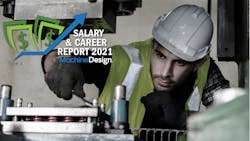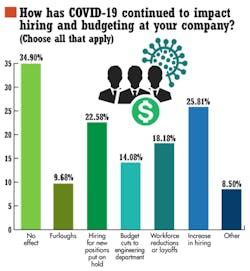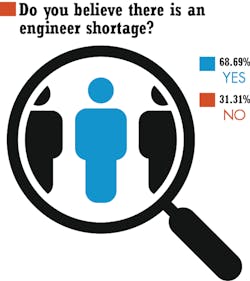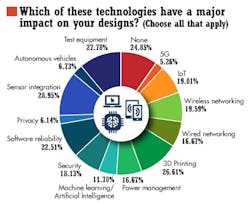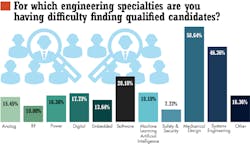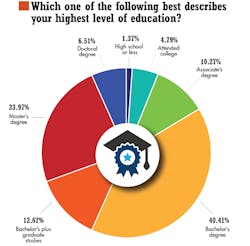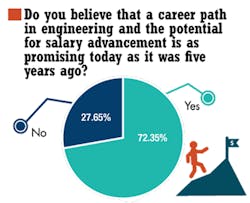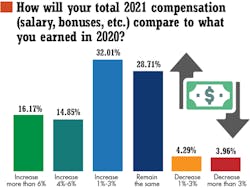The future of engineering in particular and manufacturing in general has reached a crossroads. Impacted by global economic challenges, supply chain disruptions and worker shortages, manufacturing also has faced an explosion of technology that has replaced or augmented some jobs with robotics and automation.
Yet engineers who participated in the 2021 Machine Design Salary & Career Survey were generally optimistic about their profession’s short-term benefits and longer-term future. As one respondent put it, “Engineering is not for everyone, but for someone with strong technical interests it can be very rewarding. With all the available jobs, a young candidate can “test the waters” in a couple different fields before settling on a long-term path.”
Another took a more pragmatic approach to the opportunities available in engineering. “[It’s a] great field that is constantly growing. If you want to travel with your job, you can. If you want to stay home with almost no travel, you can,” he wrote. “There are lots of opportunities to either develop new tech or adapt the new tech to current problems or issues. And with the shortage of labor, engineers are always needed to help automate things to make better use of the few employees that choose to still go to work.”
The engineers who responded to this year’s survey come from a variety of disciplines. The majority of this group either are design or project engineer, have project management responsibilities or head up research and development. About 7% of respondents are in executive management.
Regardless of job title, the last two years have been enormously challenging for everyone. Yet engineers remain positive about their profession and its value to themselves, and to society as a whole. Regardless of their field, level of experience or compensation, engineers surveyed are satisfied with their present profession and optimistic about its future.
The Impact of COVID
12% of the group have changed jobs in the last year, and while 27.5% of those changes were promotions, and 15% were due to COVID layoffs or other job reductions, 32.5% left to pursue other opportunities. About two-thirds of respondents said their company is as focused on employee retention as it was a year ago.
36% don’t work from home at all, while 31% work from home due to COVID restrictions and another 8% will remain working from home after COVID, compared with just under 8% that worked from home before COVID.
The COVID impact has been widespread:
- 40% of respondents faced a corporate ban on travel
- 28.5% had a work-from-home mandate, compared with just 8.7% with a work-from-office mandate
- 67.2% were required to wear masks while at work.
The pandemic also had an impact on hiring and job retention—in both directions. There were job cuts for 18% of respondents, 9.6% experienced furloughs and 14% saw cuts in engineering department budgets. And while 22.5% saw a freeze on new manufacturing hires, 26% saw an increase in hiring. In 2022, 43% of respondents said their company was looking to increase hiring, while 50.5% said staffing would remain at current levels.
The use of online tools also increase—while email, phone and messaging were all primary tools, 82% used video conferencing, 41.3% employed scheduling and planning tools, 38.4% used cloud-based document management and another 15% used an industry-specific collaboration tool. While 30% attending conferences through virtual event platforms.
In looking at compensation, the majority of respondents (53%) said there was no change in compensation, with 14.5% reporting a freeze on raises and 11% noting that bonuses were cancelled. Overall, 18.9% reported a salary increase and 5.8% said there was a salary decrease.
The Role of Technology
Technology played a major role in helping manufacturers stay connected in the throes of the pandemic, but widespread use of technology on the plant floor remains a future project. While technologies such as the Internet of Things (IoT) is used in 18.9% of facilities, 19.5% employ wireless technology and 18% use some form of security, a full one-quarter of respondents use none of the technology advances of the last decade. One encouraging sign: 26.5% of respondents mentioned 3D printing, the largest single area cited in the survey.
Technology advancements are being embraced in some areas of the profession. “If you can find the right company and right attitude of employer, engineering can be an amazing career path simply due to the huge variety of possibilities, and now the speed of innovation is greater than ever,” one respondent wrote.
Present Experience, Future Opportunities
The Machine Design audience is experienced—62% of respondents have been in engineering at least 20 years, and 28% have been in the field more than 35 years. There are 62% of respondents over the age of 50, and 35.7% are above the age of 60. They also are well-educated, with 84% having earned at least a bachelor’s degree, and 23.7% earning a master’s degree. They also remain bullish on the industry—almost three-quarters of respondents say the future for engineering is as promising as it was five years ago, and 90% recommend engineering as a career path for a young person.
That recommendation carries with it the reality of a shortage of engineers, particularly with so many engineers nearing retirement age. The current disconnect between unemployed workers and job openings is especially chronic in manufacturing and engineering, and 68% of respondents said they believe there is a shortage of engineers, while 70.5% said their company is having difficulty finding engineers for open positions. Positions for systems engineers (46.6%) and mechanical design (58.4%) are in particularly short supply.
“The baby boomer generation is due to start retiring en masse,” noted one respondent. “Without a steady supply of new, young engineers to replace the retirees, the profession will face an employment crisis.”
One area that does challenge the current engineering base is their workload. Of those who would consider leaving the profession, 37% said there was no further room for advancement, while 42% cited stress and 37.7% said burnout as contributing factors. Still, 50% said they’d leave just to try something different, 40% would leave to do something more fulfilling and 39.2% would consider a change to make more money.
While COVID was cited by about 15% of respondents as contributing to their stress, other business-related areas garnered far more attention. Issues such as product deadlines, the availability of components, product quality and reliability and price and performance were far greater issues for engineers.
Salary and Satisfaction
The issue of job satisfaction did have a dollar sign attached to it—more than 80% said their pay was an important, if not critical consideration. The job challenges—areas such as finding the best designs, seeing those designs reach their potential, the collaborative nature of design and the recognition of their work by company management and customers all were significant factors in job satisfaction—all garnered significant support as well, and the opportunity to design products that can benefit society held almost the same level of importance as salary to the respondents. As one respondent put it, “Engineering allows a person to grow personally and professionally while being challenged to make a difference to society in general.”
Their views on future employment appear to be evenly divided. While 11.5% are actively seeking new employment, 28.4% said they had no immediate plans to change jobs. The group in the middle also was evenly split—31.2% would respond to an interesting opportunity they heard about, while another 28.7% would respondent if recruited for such an opportunity.
The compensation levels tend to reflect the level of experience of the Machine Design audience respondents. While there are outliers at both ends of the salary spectrum, the general salary compensation range is between $70,000 and $200,000 a year. The largest percentage range was between $100,000 and $125,000, with 29.7% reporting salaries in that range. There were 31% reporting salaries in the range from $125,000 to $200,000 and 22.3% between $70,000 and $100,000. Their satisfaction with that compensation is also relatively high—59% rate it as at least competitive with others in the profession, and 61.3% consider themselves adequately compensated.
Other compensation and benefits areas included:
- Stock or stock options—76.7% reported no such benefit
- Bonuses, while 26.5% reported no bonus plan, 34.5% reported a bonus program of at least $5,000—and 18% reported a bonus plan above $10,000. The bonuses are primarily based on personal performance and the performance of the company or division.
Respondents are expecting their compensation to increase in 2022—31.8% see an increase of at least 4%, and 63% see some sort of increase for the year. Just 8.5% are projecting a salary decrease.
But while compensation is a measuring stick for job satisfaction, it is not what drives many of the Salary & Career Survey respondents. “I compare engineering to art,” one engineer wrote. “I get to create masterpieces that solve a problem or provide a service. I have designed and built machines and process for many years. It is the act of creation, just like art. At the end of the day, one can look back and say, ‘I did that’.”
About the Author

Bob Vavra
Editor Emeritus, Machine Design and Power & Motion
Bob Vavra is the former senior content director of Machine Design and Power & Motion.
